Xylophanes crotonis
|
|
Updated as per
AN ANNOTATED CHECKLIST OF THE SPHINGIDAE OF BOLIVIA, October 2007
Updated as per personal communication with Pia oberg (Wildsumaco Lodge, Napo, Ecuador, February 27, 2011, 1400m): November 30, 2011
Updated as per personal communication with Jose Ramon Alvarez Corral (91mm, Merida, Venezuela, March 2001, 2050m); May 27, 2012
Updated as per personal communication with Ezequiel Bustos (Shilap revta. lepid. 43 (172) diciembre, 2015, 615-631 eISSN 2340-4078 ISSN 0300-5267), January 4, 2016
|
Xylophanes crotonis
zail-AH-fan-eesMKROHT-uhn-ihs
(Walker, 1856) Chaerocampa [sic]
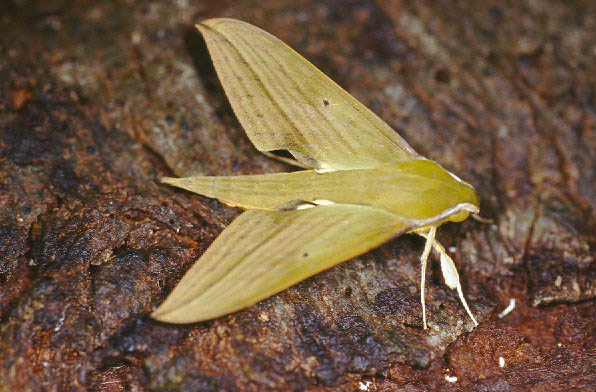
Xylophanes crotonis courtesy of Paolo Mazzei.
This site has been created by
Bill Oehlke at oehlkew@islandtelecom.com
Comments, suggestions and/or additional information are welcomed by Bill.
TAXONOMY:
Family: Sphingidae, Latreille, 1802
Subfamily: Macroglossinae, Harris, 1839
Tribe: Macroglossini, Harris, 1839
Genus: Xylophanes Hubner [1819] ...........
Species: crotonis Walker, 1856
|
MIDI MUSIC
.....It's a Wonderful World.....
copyright C. Odenkirk
ON.OFF
<bgsound src="world.mid" LOOP=FOREVER>
|
DISTRIBUTION:
Xylophanes crotonis (wingspan: males: 86-94mm; females: 100mm]
flies in
Guatemala;
Costa Rica;
and probably in Panama and in
Colombia;
Venezuela the specimen type locality (Merida (JRAC);
and south to
Ecuador: Napo (PO);
Peru: Amazonas (BC) and probably throughout Peru; and
Bolivia:
La Paz: Murillo, Zongo Cuticucho; Zongo-Pacollo;
Cochabamba: Chapare, Alto Palmar, (1100m); Chapare,
Yunga del Espíritu Santo; and
Argentina: Jujuy; Salta.
Choerocampa aristor Boisduval, 1870, Guatemala, is the same as Xylophanes crotonis.
Chaerocampa hotulanus Schaufuss, 1870, Venezuela, is the same as Xylophanes crotonis.
Chaerocampa viridescens Butler, 1875, Colombia, is the same as Xylophanes crotonis.
Theretra virescens Kirby, 1892, ?, is the same as Xylophanes crotonis.
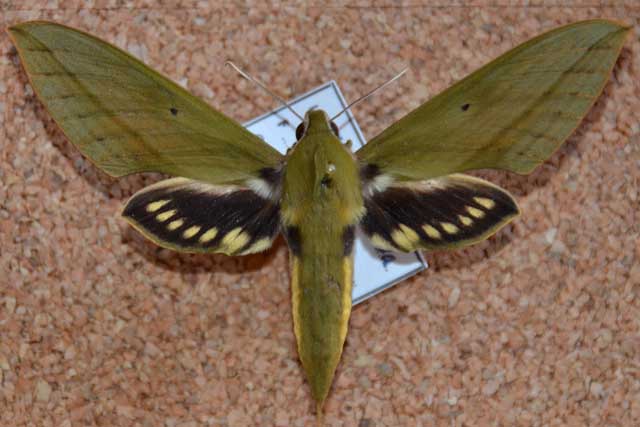
Xylophanes crotonis, 91mm, Merida, Venezuela,
March 2001, 2050m, courtesy of Jose Ramon Alvarez Corral.
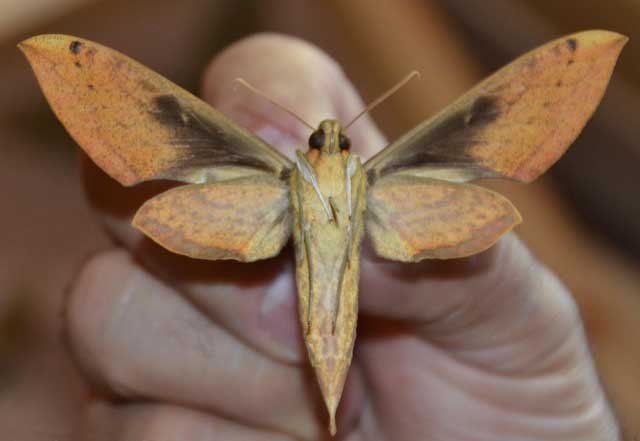
Xylophanes crotonis, 91mm, verso, Merida, Venezuela,
March 2001, 2050m, courtesy of Jose Ramon Alvarez Corral.
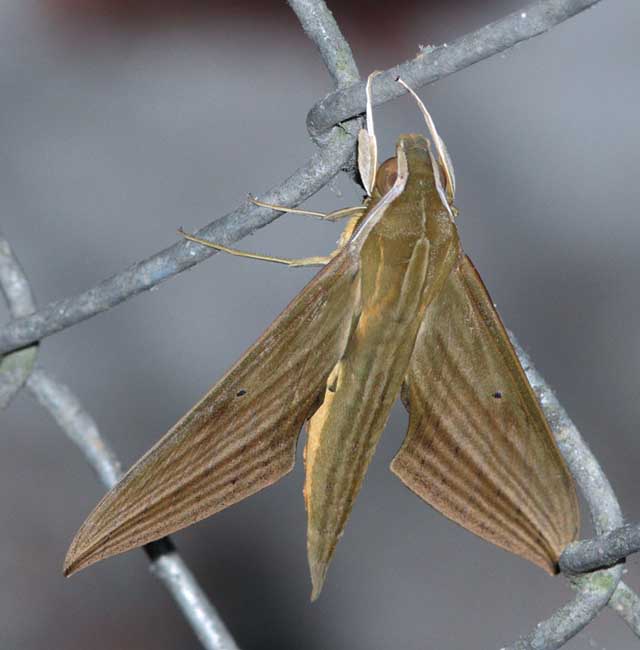
Xylophanes crotonis ??, Wildsumaco Lodge, Napo, Ecuador,
February 27, 2011, 1400m, courtesy of Pia Oberg.
"Tegulae usually without a pale median line. Upperside of body and forewings varying from olive-green (fading to brown). Each side of abdomen with a basal yellowish-white
lateral patch that extends onto the metanotum, posterior of which is a black patch and a distinct yellow stripe; dorsal lines vestigial or absent; spines along posterior
edges of posterior tergites uniseriate, single, heavy, conical.
Outer spur of midtibia longer than inner. Colour of body and forewing varying from tawny to ochre-yellow.
Forewing upperside olive-green (fading to pale brown), with a series of oblique lines running from the inner margin to the apex; first and fourth postmedian lines
generally stronger than the second, third and fifth, which are equal in intensity to the two submarginal lines.
Hindwing upperside black; median band comprising a series of teardrop-shaped pale yellow spots." CATE
The pronunciation of scientific names is
troublesome for many. The "suggestion" at the top of the page is
merely a suggestion. It is based on commonly
accepted English pronunciation of Greek names and/or some
fairly well accepted "rules" for latinized scientific names.
The suggested pronunciations, on this page and on other pages,
are primarily put forward to assist those who hear with internal
ears as they read.
There are many collectors from different countries whose
intonations and accents would be different.
Jean Marie Cadiou writes, "When I say "Xylophanes" in English I
pronounce it something like "Zailophanees", with the emphasis on the
"o". The French pronounce it differently, something like
"Kzeelophaness" with no emphasis, and the Germans yet in a
different way..."
In Greek myth, Phanes is the golden winged Primordial Being who
was hatched from the shining Cosmic Egg that was the source of the
universe. He personifies light emerging from chaos.
"Xylo" is the Greek word for wood.
The specimen type for the genus
Xylophanes is Xylophanes anubus. Perhaps ? when Hubner
examined this species, the yellow-orange and brown tones of the
forewings suggested wings of wood.
The species name "crotonis" might be from
the Greek, Croton, a former Greek town in southern Italy.
FLIGHT TIMES:
Xylophanes crotonis adults fly in every month of the year in Costa Rica. Jose Ramon Alvarez Corral
reports a March flight in Merida, Venezuela.
ECLOSION:
Pupae probably wiggle to surface from subterranean chambers or leaf litter just prior to
eclosion.
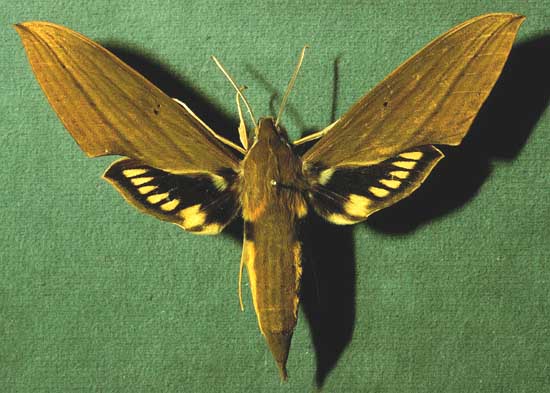
Xylophanes crotonis female courtesy of Dan
Janzen.
SCENTING AND MATING:Females call in the males with a pheromone released from a gland at the tip of the
abdomen. Males come in to lights very readily, but females are seldom taken in that way.
EGGS, LARVAE, PUPAE:
Larvae feed on
Psychotria correae, Palicourea padifolia, Palicourea salicifolia, Coussarea austin-smithii, Coussarea caroliana
and probably other members of the Rubiaceae family.
Rottboellia cochinchinensis of the Poaceae family also serves as a host.
Larvae are green without eyespots in second instar.
There is a turquoise color morph. Another variation is purplish with yellow dots all over, and a yellow lateral line,
white angled slashes on sides, and a purple tail.
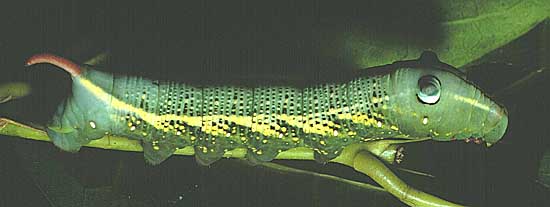
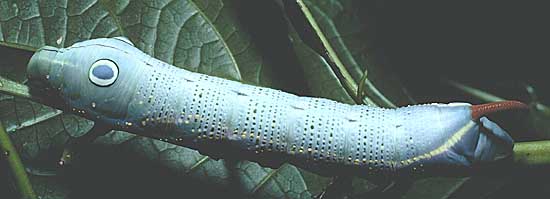
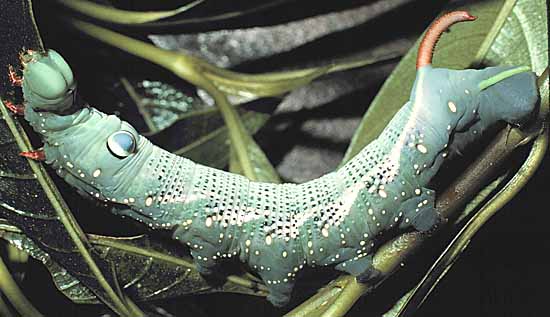
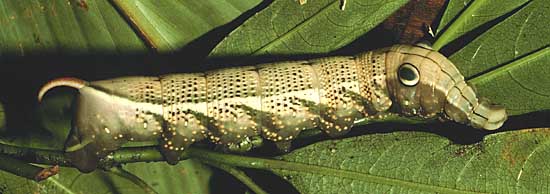
Eclosions from pupae occur about six weeks after pupation.
Larvae are subject to parasitization by Chetogena scutellaris of the Tachinidae family.
Use your browser "Back" button to return to the previous page.
Goto Main Sphingidae Index
Goto Macroglossini Tribe
Goto Central American Indices
Goto Carribean Islands
Goto South American Indices
Goto U.S.A. tables








